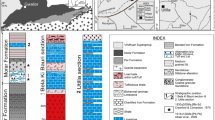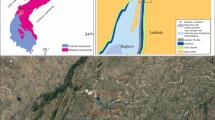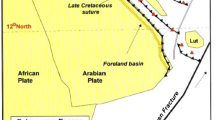Abstract
Collected from a Late Permian to Early Triassic sedimentary section in the Zhongliang Mountain of Chongqing, Southwest China, sixty marine carbonate samples were measured for the 87Sr/86Sr ratios, and corresponding evolution curve was constructed. The concentrations of SiO2, CaO, MgO, Mn and Sr are used to evaluate reservation of strontium isotopic composition for original seawater and the credibility of the dissolution method for sample preparation. The results show that most of the samples (except seven samples with the Mn/Sr ratios higher than 2) contain the original geochemistry signatures of ancient seawater. Compared to the published 87Sr/86Sr ratios from the Late Permian to Early Triassic, our database reported here is the largest and the curve constructed is the most complete. The strontium isotopic curve from Late Permian to Early Triassic is consistent globally and exhibits a general trend of steady increase during this period. The minimum of 87Sr/86Sr ratios (0.707011) occurs in the Late Permian (30 m in thickness below the Permian-Triassic boundary), and the maximum (0.708281), near the Early-Middle Triassic boundary. The lack of land plants and the rapid continental weathering result in the increase of 87Sr/86Sr ratios during the interval. The Permian-Triassic boundary in Zhongliang Mountain Section has been accepted internationally. The 87Sr/86Sr ratios of six samples near the boundary vary from 0.70714 to 0.70715 with an average of 0.70714, which is consistent with the value of 0.70715 (samples are from articulate brachiopod shells) from Korte et al. published in 2006 (within the error range in experiment). Accordingly, the strontium isotope composition in the Permian-Triassic boundary in this paper is of global significance. It can be confirmed that the 87Sr/86Sr ratios of the seawater in the Permian-Triassic transition are in the range of 0.70714–0.70715.
Similar content being viewed by others
References
Huang S J. Carbon isotopes of Permian and Permian-Triassic boundary in upper Yangtze platform and the mass extinction. Geochemica (in Chinese), 1994, 23(1): 60–68
Broglio L C, Neri C, Posenato R. The Werfen Formation (Lower Triassic) in the Costabella Mt., Uomo section. In: Italian IGCP 203 Group. Field Guide-book: Field Conference on Permian and Permian-Triassic Boundary in the South-Alpine Segment of the Western Tethys. Brescia: Società Geologica Italiana, 1986. 116–133
Lepper J, Röhling H G. Buntsandstein. Hallesches Jb. Geowiss. B, 1998, 6: 27–34
McKee E. Stratigraphy and history of the Moenkopi Formation of Triassic age. Geol Soc Am Mem, 1954, 61: 133
Korte C, Kozur H W, Bruckschen P, et al. Strontium isotope evolution of Late permian and Triassic seawater. Geochim Cosmochim Acta, 2003, 67: 47–62
Yang J D, Sun W G, Wang Z Z, et al. Variations in Sr and C isotopes and Ce anomalies in successions from China: evidence for the oxygenation of Neoproterozoic seawater. Precambrian Res, 1999, 93: 215–233
Li H Q, Cai H, Qin Z Y, et al. Strontium isotope compositions of Jixian middle-upper Proterozoic stratatype section and their significances. Acta Geosci Sin (in Chinese), 1994, 15(1–2): 232–244
Yang J D, Wang Z Z. C, O and Sr isotopes of early paleozoic strata in the kalpin area, Xinjiang. Geol Rev (in Chinese), 1994, 40(4): 377–385
Yang J D, Zhang J M, Tao X C, et al. Strontium and carbon isotope calibration of the Terminal Proterozoic. Geol J Chin Univ (in Chinese), 2000, 6(4): 533–545
Yang J D, Zheng W W, Wang Z Z, et al. Age determining of the upper Precambrian system of northern Jiangsu-Anhui by using Sr and C isotopes. J Stratigr(in Chinese), 2001, 25(1): 44–47
Zhang Z C. 87Sr/86Sr data for some middle-late Proterozoic to early Cambrian carbonate rocks in China. Geol Rev (in Chinese), 1995, 41(4): 349–354
Huang S J, Shi H, Shen L C, et al. Global correlation for strontium isotope curve in the Late Cretaceous of Tibet and dating marine sediments. Sci China Ser D-Earth Sci, 2005, 48(2): 199–209
McArthur J M, Howarth R J, Bailey T R. Strontium Isotope Stratigraphy: LOWESS Version 3: Best Fit to the Marine Sr-Isotope Curve for 0–509 Ma and Accompanying Look-up Table for Deriving Numerical Age. J Geol, 2001, 109: 155–170
Young G C, Laurie J R. An Australian Phanerozoic timescale. Oxford: Oxford University Press, 1996. 40–43, 136–148
Korte C, Jasper T, Kozur H W, et al. 87Sr/86Sr record of Permian seawater. Paleogeogr Paleoclimatol Paleoecol, 2006, 240: 89–107
Zhan C K, Jiang W J. The discovery of Permian-Triassic transition bed and its significance. Acta Geol Sichuan (in Chinese), 1984, 4(1): 66–74
Zhan C K, Jiang W J. The Permian-Triassic transition bed in the Mt. Zhongliang area, Chongqing. Regional Geol China (in Chinese), 1989, 8(2): 168–174
Zhou L, Kyte F T. The Permian-Triassic boundary event: a geochemical study of three Chinese sections. Earth Planet Sci Lett, 1988, 90: 411–421
Zhou Y Q, Chai Z F, Mao X Y, et al. Rare earth geochemistry of clays at and near the Permian-Triassic boundary in south China. Geotectonica et Metallogenia (in Chinese), 1989, 3(2): 188–196
Yang Z Y, Wu S B, Yin H F, et al. Geological events of Permo-Triassic transitional period in South China (in Chinese). Beijing: Geological Publishing House, 1991. 1–183
Huang S J. Clay minerals in clay rocks near P/T boundary from Guangyuan and Chongqing, Sichuan. J Chengdu College Geol (in Chinese), 1992, 19(3): 66–73
Huang S J. Microspherulitic and clastic mineral in the clay rock near the Permian-Triassic interface of Zhongliangshan Mountain, Chongqing. Acta Sediment Sin (in Chinese), 1993, 11(3): 105–113
Yao J X, Li Z S, Zhan L P, et al. A quantitative conodont biostratigraphy for Permian and Triassic and their mutual boundaries in China. Sci China-Ser B, 1993, 36: 366–374
Tong J N, Kuang W. A study of the Changxingian foraminifera and microfacies in Liangfengya, Chongqing, Sichuan province. Earth Sci—J China Univ Geosci (in Chinese), 1990, 15(3): 337–344
Shen S Z, He X L. Changxingian brachiopod assemblage sequence in Zhongliang Hill, Chongqing. J Stratigr (in Chinese), 1991, 15(3): 189–196
Zhu M L, Zhang S J. Brachiopoda in the Changxing formation in Zhongliangshan, Chongqing. Acta Geol Sichuan (in Chinese), 1992, 12(2): 107–111
He X L, Shen S Z. Study of the biotic succession near the Permo-Triassic boundary of the Zhongliang Hill, Chongqing. J Stratigr (in Chinese), 1988, 12(4): 268–272
Tong X S, Tang Y. Storm deposits in early Triassic first member (Feixianguan Formation) of Liangfengya, Chongqing. Acta Sediment Sin (in Chinese), 1990, 8(3): 121–127
Hu Z S, Zhao Y S. Storm deposits in Member III of Feixianguan Formation, Triasic Series in Zhongliang Mountain, Chongqing. Acta Sediment Sin (in Chinese), 1993, 11(2): 84–90
Huang S J. Cathodoluminescence and diagenetic alteration of marine carbonate minerals. Sediment Facies Paleogeogr (in Chinese), 1990, 10(4): 9–15
Huang S J, Shi He, Mao X D, et al. Diagenesic alteration of Earlier palaeozonic paleozoic marine carbonate and preservation for the information of sea water. J Chengdu Univ tech (Sci & Tech ed) (in Chinese), 2003, 30(1): 9–18
McArthur J M, Thirlwall M F, Chen M, et al. Strontium isotope stratigraphy in the Late Creta ceous: numerical calibration of the Sr isotope curve and intercontinental correlation for the Campanian. Paleoceanography, 1993, 8: 859–873
McArthur J M, Thirlwall M F, Gale A S, et al. Strontium isotope stratigraphy for the Late Cretaceous: a new curve, based on the English chalk. In: Hailwood E A, Kidd R B, eds. High Resolution Stratigraphy. Amsterdam: Elsevier, 1993. 195–209
McArthur J M, Kennedy W J, Chen M, et al. Strontium isotope stratigraphy for Late Cretaceous time: direct numerical calibration of the Sr isotope curve based on the US western interior. Paleogeogr Paleoclimatol Paleoecol, 1994, 108: 95–119
Bailey T R, McArthur J M, Prince H, et al. Dissolution methods for strontium isotope stratigraphy: Whole rock analysis. Chem Geol, 2000, 167: 313–319
McArthur J M. Recent trends in strontium isotope stratigraphy. Terra Nova, 1994, 6: 331–358
Kaufman A J, Knoll A H, Awramik S M. Biostratigraphic and chemostratigraphic correlation of Neoproterozoic sedimentary successions: Upper Tindir Group, northwestern Canada, as a test case. Geology, 1992, 20: 181–185
Kaufman A J, Jacobsen S B, Knoll A H. The Vendian record of Sr-and C-isotope variations in seawater: Implications for tectonics and paleoclimate. Earth Planet Sci Lett, 1993, 120: 409–430
Huang S J. Cathodoluminescence and diagenetic alteration of marine carbonate mineral. J Mineral Petrol (in Chinese), 1992, 12(4): 74–79
Brand U, Veizer J. Chemical diagenesis of multicomponent carbonate system — 2: Trace elements. J Sediment Petrol, 1980, 50: 1219–1236
Livingstone D A. Chemical composition of rivers and lakes. In: Data of Geochemistry (USGS Professional Papers 440G). Denver: US Geological Survey, 1963. 41–44
Mason B. Principles of Geochemistry. 3rd ed. New York: John Wiley & Sons Inc, 1966. 194–199
Huang S J, Qing H R, Hu Z W, et al. Cathodoluminescence and diagenesis of the carbonate rocks in the Feixianguan formation of Triassic, Eastern Sichuan basin of China. Earth Sci — J Chin Univ Geosci (in Chinese), 2008, 33(1): 26–34
Walter M R, Veevers J J, Calver C R, et al. Dating the 840-544 Ma Neoproterozoic interval by isotopes of strontium, carbon, and sulfur in seawater, and some interpretative models. Precambrian Res, 2000, 100: 371–433
Veizer J, Ala D, Azmy K, et al. 87Sr/86Sr, δ 13C and δ 18O evolution of Phanerozoic seawater. Chem Geol, 1999, 161: 59–88
Derry L A, Keto L, Jacobsen S, et al. Sr isotopic variations in Upper Proterozoic carbonates from Svalbard and East Greenland. Geochim Cosmochim Acta, 1989, 53: 2331–2339
Huang S J, Sun Z L, Wu S J, et al. Strontium isotope composition and control factors of global seawater in Triassic. J Mineral Petrol (in Chinese), 2006, 26(1): 43–48
Mundil R, Ludwig K R, Metcalfe L, et al. Age and timing of the Permian mass extinctions: U/Pb dating of closed system zircons. Science, 2004, 305: 1760–1763
Wang Y B, Liu D Y, Yao J X, et al. Age derermination of the Lower-Middle Triassic boundary at Ganheqiao, Wangmo, Guizhou Province. Acta Geol Sin (in Chinese), 2004, 78(5): 587–590
Zhou Y Q, Chai Z F, Mao X Y, et al. The strontium isotope anomaly event across the Permian/Triassic boundary section in Meishan, Zhejiang, China. J Graduate School, USTC(in Chinese), 1990, 7(1): 83–88
Huang S J, Zhou S H. Carbon and strontium isotopes of Late Palaeozoic marine carbonates in the Upper Yangtze platform, southwest China. Acta Geol Sin, 1997, 71(3): 282–292
Veizer J, Ala D, Azmy K, et al. 87Sr/86Sr, δ 13C and δ 18O evolution of Phanerozoic seawater. Chem Geol, 1999, 161: 59–88
Luo Z L, Yong Z Q, Liu S G, et al. Divergent role of “Emei Tafrogeny” on Yangtse Palaeoslab and Tarim Palaeoslab and its significance in geoscience. Xinjiang Petrol Geol (in Chinese), 2004, 25(1): 1–7
Erwin D H. The Great Paleozoic Crisis. New York: Columbia University Press, 1993. 1–327
Hallam A. Mass Extinction and Their Aftermath. London: Oxford University Press, 1997. 94–141
Oberbeck V R. Impacts, tillites and breakup of Gondwana land. J Geol, 1993, 101: 1–19
Stampfli G M. Tethyan oceans. In: Bozkurt E, Winchester J A, Piper J D A. Tectonics and Magmatism in Turkey and Surrounding Area. London: Geological Society of London, 2000. 1–23
Stampfli G M, Mosar J, Favre P, et al. Permo-Mesozoic evolution of the western Tethyan realm: the Neotethys/East-Mediterranean connection. In: Ziegler P A, Cavazza W, Robertson A H F, et al. PeriTethys Memoir 6 Mém: Peritethyan Rift/Wrench Basins and Passive Margins, IGCP 369. Paris: Museum Nat Hist Nat, 2001. 51–108
Gradstein F M, Ogg J G, Smith A G, et al. A Geologic Time Scale 2004. Cambridge: Cambridge University Press, 2004. 249–270
Claoue-Long J C, Zhang Z C, Ma G G, et al. The age of the Permain-Triassic boundary. Earth Planet Sci Lett, 1991, 105: 181–190
Huang S J, Pei C R, Qing H R, et al. Age calibration for the boundary between Lower and Middle Triassic by strontium isotope stratigraphy in eastern Sichuan. Acta Geol Sin (in Chinese), 2006, 80(11): 1691–1698
Author information
Authors and Affiliations
Corresponding author
Additional information
Supported by the National Natural Science Foundation of China (Grant No. 40472068, 40672072) and the Research Fund for the Doctoral Program of Higher Education of China (Grant No. 20050616005)
Rights and permissions
About this article
Cite this article
Huang, S., Qing, H., Huang, P. et al. Evolution of strontium isotopic composition of seawater from Late Permian to Early Triassic based on study of marine carbonates, Zhongliang Mountain, Chongqing, China. Sci. China Ser. D-Earth Sci. 51, 528–539 (2008). https://doi.org/10.1007/s11430-008-0034-3
Received:
Accepted:
Published:
Issue Date:
DOI: https://doi.org/10.1007/s11430-008-0034-3




